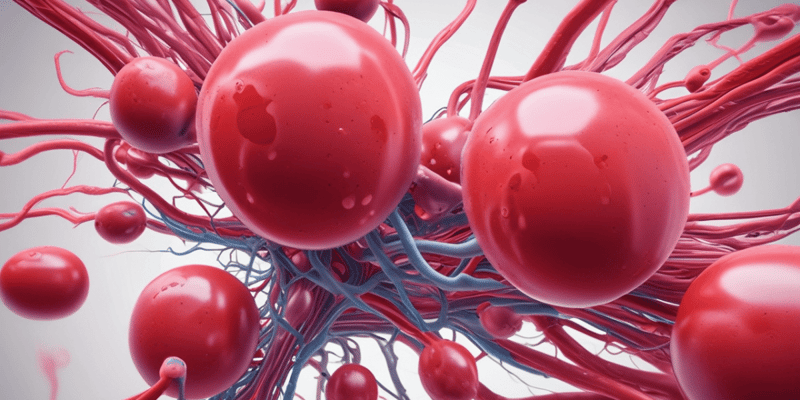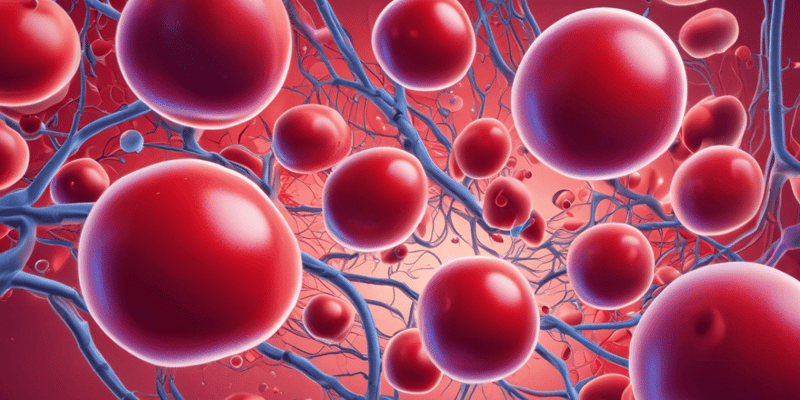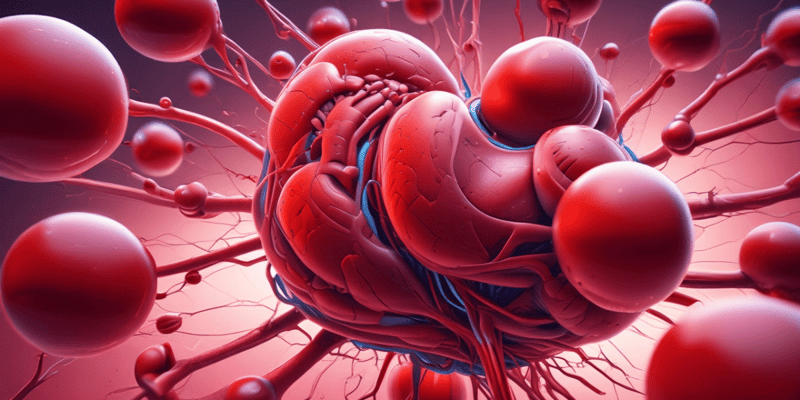42 Questions
Plasma is made up of water, dissolved gases, nutrients, waste products, and proteins. It constitutes ___% of centrifuged blood.
55
The buffy coat in centrifuged blood contains white blood cells (WBCs) and ___.
Platelets
Erythrocytes lack a nucleus and have a biconcave disc shape. They carry oxygen and some carbon dioxide due to the presence of ___ in them.
hemoglobin
Neutrophils, Basophils, and Eosinophils belong to the category of leukocytes known as ___.
Granulocytes
RBCs are formed in the red bone marrow from the hematopoietic stem cell, myeloid stem cell, erythroblast, reticulocyte, and finally the mature ___ cell.
RBC
The three steps to hemostasis are vascular spasm, platelet plug formation, and ___.
Coagulation
The layers of the heart wall include Epicardium, Myocardium, and ___.
Endocardium
The left ventricle is the thickest since it sends blood against gravity to the ______.
brain
Heart valves: AV valves include Tricuspid for the right side and Bicuspid/Mitral for the ______ side.
left
Semilunar valves include Pulmonic for the right ventricle and pulmonary trunk, and Aortic for the left ventricle and ______.
aorta
Microscopic anatomy of the heart muscle: short, fat, branched, uninucleated, striated, involuntary, ______ disc.
intercalated
Physiology of cardiac muscle contraction: Autorhythmic cells depolarize through leakage of ______.
potassium
Blood flow through the heart: Superior vena cava, Inferior vena cava, and Coronary sinus; Right atrium; Tricuspid valve; Right ventricle; Pulmonary semilunar valve; Pulmonary trunk; Right and Left Pulmonary Arteries; Lungs; Right and Left Pulmonary Veins; Left Atrium; Bicuspid/Mitral valve; Left ventricle; Aortic valve; ______.
aorta
Electrical conduction system of the heart and electrocardiogram: SA node, AV node (bundle), Bundle branches, Purkinje fibers P wave – atrial depolarization PQ interval – ventricular filling QRS Complex – Ventricular depolarization ST segment – ventricular emptying ______.
T wave
Cardiac cycle: Systolic versus Diastolic - Atrial Systole/Ventricular Diastole – AV valves OPEN, Semilunar valves CLOSED. Atrial Diastole/Ventricular Systole – AV valves CLOSED, Semilunar valves OPEN Matching electrical conduction to heart systole vs diastole Pressure and volume ______.
relation
Match the heart valve with its corresponding chamber:
Tricuspid = Right atrium Bicuspid/Mitral = Left atrium Pulmonic = Right ventricle Aortic = Left ventricle
Match the heart structure with its function:
SA node = Initiates electrical impulses Purkinje fibers = Rapidly conducts impulses to myocardium Coronary circulation = Supplies oxygenated blood to the heart muscle Bundle branches = Transmit impulses to ventricular myocardium
Match the heart phase with its description:
Atrial Systole/Ventricular Diastole = AV valves OPEN, Semilunar valves CLOSED Atrial Diastole/Ventricular Systole = AV valves CLOSED, Semilunar valves OPEN Depolarization process = SA node → AV node → Bundle branches → Purkinje fibers Electrocardiogram component = ST segment - ventricular emptying
Match the blood vessel with its destination:
Superior vena cava = Enters the right atrium Pulmonary arteries = Carries deoxygenated blood to the lungs Left pulmonary veins = Returns oxygenated blood to the left atrium Aorta = Distributes oxygenated blood to the body
Match the cardiac muscle characteristic with its description:
Short, fat, branched, striated = Microscopic anatomy of the heart muscle Intercalated disc = Facilitates rapid conduction of impulses between cardiac cells Involuntary muscle type = Contracts without conscious control Autorhythmic cells depolarization process = Leakage of potassium ions
Match the following blood components with their respective compositions:
Plasma = water, dissolved gases, nutrients, waste products, proteins Buffy Coat = WBCs and Platelets Hematocrit (Erythrocyte) = RBCs Formed Elements = RBCs, WBCs, Platelets
Match the leukocyte types with their percentages in circulation:
Neutrophils = 60% Lymphocytes = 30% Monocytes = 8% Eosinophils = 3%
Match the components of hemoglobin recycling with their functions:
Bilirubin = product of heme breakdown, gives feces its color Biliverdin = green pigment formed during heme breakdown Stercobilin = brown pigment in feces formed from bilirubin Transferrin = transports iron in the blood
Match the leukocyte categories with their respective cell types:
Granulocyte = Neutrophils, Basophils, Eosinophils Agranulocyte = Monocytes, Lymphocytes Lymphoid Stem Cells = B-cell lymphocytes, T-cell lymphocytes, Natural Killer cells Myeloid Stem Cells = RBCs, Platelets, Monocytes, Neutrophils, Eosinophils, Basophils
Match the types of leukocytes with their functions:
Neutrophils = phagocytize pathogens and dead neutrophils Lymphocytes = mount immune response against cancer cells and viruses Monocytes = phagocytize pathogens and debris of dead cells Eosinophils = phagocytize antigen-antibody complexes, allergens, and inflammatory chemicals
Match the steps of hemostasis with their descriptions:
Vascular spasm = initial constriction of a blood vessel to reduce blood flow Platelet plug formation = platelets adhere to damaged area forming a temporary seal Coagulation (Common pathway) = conversion of fibrinogen to fibrin to form a stable clot Clot retraction = contraction of clot to reduce size after healing
Match the heart wall layers with their descriptions:
Epicardium = (same as visceral pericardium) outer layer of the heart wall Myocardium = (contains cardiac muscle) middle layer responsible for contraction Endocardium = (inner layer) lining the chambers of the heart
Match the following blood disorders with their descriptions:
Polycythemia = Excessive production of red blood cells Anemia = Decreased red blood cell count or hemoglobin levels Sickle-cell Disease = Genetic disorder affecting hemoglobin structure Hemophilia = Impaired blood clotting due to lack of specific clotting factors
Match the leukocyte types with their respective stem cells:
Neutrophils = Myeloid stem cells Lymphocytes = Lymphoid stem cells Monocytes = Myeloid stem cells Eosinophils = Myeloid stem cells
Match the components of hemostasis with their functions:
Vascular spasm = Initial constriction of blood vessels to reduce blood flow Platelet plug formation = Platelets adhere to damaged area to form temporary seal Coagulation = Formation of fibrin mesh to stabilize platelet plug Clot retraction = Contraction of clot to reduce size and promote healing
Match the leukocyte categories with their respective functions:
Granulocytes (Neutrophils, Basophils, Eosinophils) = Phagocytosis and inflammation response Agranulocytes (Monocytes, Lymphocytes) = Immune response and antigen recognition
Match the heart valves with their corresponding structures:
Tricuspid valve = Right atrioventricular valve Bicuspid/Mitral valve = Left atrioventricular valve Pulmonic semilunar valve = Right ventricle and pulmonary trunk exit Aortic semilunar valve = Left ventricle and aorta exit
Match the components of hemoglobin recycling with their functions:
Bilirubin = Yellow pigment from breakdown of heme in liver Biliverdin = Green pigment from heme breakdown before conversion to bilirubin Stercobilin and urobilinogen = Brown pigments in feces and urine from bilirubin metabolism Transferrin = Iron transport protein in blood plasma
Match the leukocyte functions with their descriptions:
Neutrophils = Phagocytize pathogens and release enzymes for digestion Lymphocytes = Mount immune responses through T and B cell activities Monocytes = Phagocytize dead cells, debris, and present antigens to lymphocytes Eosinophils = Combat parasitic infections and modulate allergic reactions
Match the heart valve with the chamber it corresponds to:
Tricuspid = Right atrium Bicuspid/Mitral = Left atrium Pulmonic = Right ventricle Aortic = Left ventricle
Match the heart phase with its description:
Atrial Systole = AV valves OPEN, Semilunar valves CLOSED Ventricular Diastole = AV valves CLOSED, Semilunar valves OPEN Ventricular Systole = AV valves CLOSED, Semilunar valves OPEN Atrial Diastole = AV valves OPEN, Semilunar valves CLOSED
Match the heart structure with its function:
SA node = Initiates heartbeat by generating electrical impulses Bundle branches = Transmit electrical impulses to the Purkinje fibers Purkinje fibers = Distribute electrical signals for coordinated muscle contraction AV node = Delays impulse to allow ventricles to fill before contraction
Match the cardiac muscle characteristic with its description:
Uninucleated = Contains a single nucleus per cell Striated = Displays a striped appearance under the microscope Branched = Has a branching pattern for efficient signal transmission Involuntary = Contracts without conscious control
Match the blood flow pathway through the heart with the structures involved:
Superior vena cava = Returns deoxygenated blood from upper body to right atrium Pulmonary semilunar valve = Prevents backflow of blood from pulmonary trunk to right ventricle Right and Left Pulmonary Veins = Carry oxygenated blood from lungs to left atrium Aortic valve = Regulates blood flow from left ventricle to aorta
Match the components of cardiac muscle contraction with their functions:
Leakage of potassium = Initiates autorhythmic depolarization of cardiac cells Voltage-gated sodium channels = Allow rapid influx of sodium ions during depolarization phase Slow voltage calcium channels = Contribute to sustained influx of calcium for muscle contraction Voltage-gated potassium channels = Responsible for repolarization and restoring resting membrane potential
Match the features of an electrocardiogram (ECG) with their corresponding events in the cardiac cycle:
P wave = Atrial depolarization QRS Complex = Ventricular depolarization ST segment = Ventricular emptying phase T wave = Ventricular repolarization
Match the types of leukocytes with their respective functions:
Neutrophils = Phagocytize pathogens and debris in inflammation Basophils = Release histamine during allergic reactions Eosinophils = Combat parasitic infections and modulate allergic responses Lymphocytes = Coordinate immune responses through antibody production or cell-mediated immunity
Test your knowledge on the general functions of the cardiovascular system, composition of blood, different parts of centrifuged blood, and the three formed elements found in blood. Explore topics such as erythrocytes, leukocytes, platelets, and more.
Make Your Own Quizzes and Flashcards
Convert your notes into interactive study material.
Get started for free



